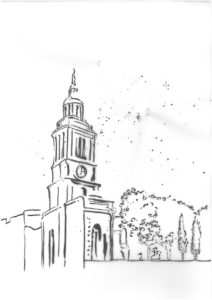Sound functions as a literary device in William Baldwin’s Beware the Cat (c. 1552). This early novel recounts the tale of a curious priest and the alchemical consumption that enables him to open his ears in an exceptional way: he can understand the language of cats.
Gregory Streamer, the priest in question, is kept awake one night by ‘wawling’ (11) felines on the roof of his lodgings.1 When he tells his housemates about it the next day, a group of raconteurs only too keen to spin yarns, there ensues an extended conversation about cats: magical cats, vengeful cats, and very articulate cats. Tall tales indeed – not least the one about the puss who ate a cow and a sheep. But this is Baldwin’s point. The wrong kind of stories lull the listener with hearsay and superstition. As the marginal gloss (in the voice of ‘G.B.’, a veiled version of the author) advises, ‘unwritten verities’ are like ‘witchcraft […] for both go by traditions’ (19). The particular traditions at which Beware the Cat takes aim are those of Catholicism. Secret masses, animated Madonnas, and miraculous healings all receive pointed mockery.

One side of the sound coin, then, warns us to close our ears against misleading human chatter. The other side reveals the expansive possibilities of listening to voices from the non-human world. This is not to say the text greets those voices on their own terms. Streamer’s first, and persisting, instinct is to formulate them through human culture. Before ingesting his homemade sense-bending pills and fluids, Streamer hears the cats as a discordant choir, complete with a mewling voice that ‘crying like a young child, squealed out the shrieking treble’ (23). This ear-splitting, inharmonious music anticipates one of the most striking sections of the book, Baldwin’s recreation of London’s soundscape.
Amongst the ‘disordered and monstrous’ (31) universal cacophany that Streamer discerns when his self-medication takes effect, he picks out the music of the spheres. With this gesture towards celestial sound Baldwin marks aurality as a means of accessing transcendence. But like the cat choir, such glory is pulled sharply back to earth by the ‘broil’ (31) that follows. In a section of prose that sings out in Skeltonics, the urban world resounds for the reader in all its deafening disarray. Alongside such merry, playful noises as ‘peeping of mice, trulling of dice’, Streamer hears the intimately physical ‘snorting of slaves, farting of churls, fizzling of girls’ (32). In a pattern characteristic of the text’s dual approach to sound, Baldwin’s rattling participles repeatedly alternate the lyrical with the mundane: ‘counting of coins, mounting of groins, whispering of lovers, springling of plovers’ (32). Sound in this text extends us beyond the quotidian, but still reminds us of our mortal limitations.
This is a point that the marginal gloss is keen to emphasise. When Streamer waxes lyrical over his aural experiences, G.B. remarks drily from the margin: ‘here the poetical fury came upon him’ (32). G.B. is mocking Streamer’s literary pretensions, but thanks to its sonic qualities, this section is the most poetical in the text. Baldwin moreover establishes for his book a particular intertextual relationship with The House of Fame (1379-80), allowing both Streamer and the gloss to cite Chaucer’s dream vision. This poem centres around an astral castle to which all sound ascends: ‘what so cometh from any tonge, / Be it rouned [whispered], red, or songe’ (II.721-2).2 In Chaucer’s house are to be found generations of poets and musicians, eternised by their sound-works. So Baldwin’s allusion affirms the resonance of poetic creation – the ‘whispering of lovers, springling of plovers’ (32) that make up the chorus of literary inheritance. But Chaucer’s dream vision infamously ends in the creaking, swirling house of rumour filled with jangling strife and gossip. Baldwin’s echo of Chaucer, like much of Beware the Cat, suggests the perils of gullible listening, even as it charms the reader with its giddy narrative.
1 William Baldwin, Beware the Cat, ed. William A. Ringler, Jr. and Michael Flachmann (San Marino: Huntington Library, 1988).
2 Geoffrey Chaucer, The House of Fame in The Riverside Chaucer, ed. Larry D. Benson (Oxford: Oxford University Press, 1988).
********************
Rachel Stenner, in collaboration with Frances Babbage from the University of Sheffield, and Terry O’Connor, founder member of the Ibsen Award-winning ensemble Forced Entertainment, has adapted Beware the Cat for theatrical performance. Following events in Sheffield and Brighton, it is showing at the RSC on Saturday July 6th and the Workshop Theatre in Leeds on Friday 22nd November. You can read more about the project on its blog or @BewareCat.
Feature image: ‘Bell’ © Penny McCarthy; part of a series drawn for “Beware the Cat”.
